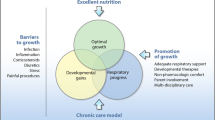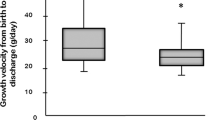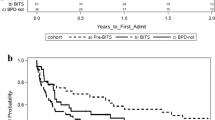Abstract
Objective:
To characterize the treatments and short-term outcomes in infants with severe bronchopulmonary dysplasia (sBPD) referred to regional neonatal intensive care units.
Study Design:
Infants born <32 weeks’ gestation with sBPD were identified using the Children’s Hospital Neonatal Database. Descriptive outcomes are reported.
Result:
A total of 867 patients were eligible. On average, infants were born at 26 weeks’ gestation and referred 43 days after birth. Infants frequently experienced lung injury (pneumonia: 24.1%; air leak: 9%) and received systemic corticosteroids (61%) and mechanical ventilation (median duration 37 days). Although 91% survived to discharge, the mean post-menstrual age was 47 weeks. Ongoing care such as supplemental oxygen (66%) and tracheostomy (5%) were frequently needed.
Conclusion:
Referred infants with sBPD sustain multiple insults to lung function and development. Because affected infants have no proven, safe or efficacious therapy and endure an exceptional burden of care even after referral, urgent work is required to observe and improve their outcomes.
This is a preview of subscription content, access via your institution
Access options
Subscribe to this journal
Receive 12 print issues and online access
$259.00 per year
only $21.58 per issue
Buy this article
- Purchase on Springer Link
- Instant access to full article PDF
Prices may be subject to local taxes which are calculated during checkout
Similar content being viewed by others
References
Ehrenkranz RA, Walsh MC, Vohr BRB, Jobe AH, Wright LL, Fanaroff AA et al. Validation of the National Institutes of Health consensus definition of bronchopulmonary dysplasia. Pediatrics 2005; 116 (6): 1353–1360.
Schmidt B, Asztalos EV, Roberts RS, Robertson CM, Sauve RS, Whitfield MF et al. Impact of bronchopulmonary dysplasia, brain injury, and severe retinopathy on the outcome of extremely low-birth-weight infants at 18 months: results from the trial of indomethacin prophylaxis in preterms. JAMA 2003; 289 (9): 1124–1129.
Bassler D, Stoll BJ, Schmidt B, Asztalos EV, Roberts RS, Robertson CM et al. Using a count of neonatal morbidities to predict poor outcome in extremely low birth weight infants: added role of neonatal infection. Pediatrics 2009; 123 (1): 313–318.
Jobe AH . The new bronchopulmonary dysplasia. Curr Opin Pediatr 2011; 23 (2): 167–172.
Walsh MC, Szefler S, Davis J, Allen M, Van Marter L, Abman S et al. Summary proceedings from the bronchopulmonary dysplasia group. Pediatrics 2006; 117 (3 Pt 2)): S52–S56.
Stoll BJ, Hansen NI, Bell EF, Shankaran S, Laptook AR, Walsh MC et al. Neonatal outcomes of extremely preterm infants from the NICHD Neonatal Research Network. Pediatrics 2010; 126 (3): 443–456.
Natarajan GG, Pappas AA, Shankaran SS, Kendrick DE, Das AA, Higgins RD et al. Outcomes of extremely low birth weight infants with bronchopulmonary dysplasia: Impact of the physiologic definition. Early Hum Dev 2012; 88 (7): 509–515.
American Academy of Pediatrics Committee on Fetus & Newborn. Levels of neonatal care. Pediatrics 2012; 130 (3): 587–597.
Schmidt B, Roberts RS, Davis P, Doyle LW, Barrington KJ, Ohlsson A et al. Caffeine therapy for apnea of prematurity. N Engl J Med 2006; 354 (20): 2112–2121.
Askie LM, Ballard RA, Cutter GR, Dani CC, Elbourne DD, Field DD et al. Inhaled nitric oxide in preterm infants: an individual-patient data meta-analysis of randomized trials. Pediatrics 2011; 128 (4): 729–739.
Ballard RA, Truog WE, Cnaan A, Martin RJ, Ballard PL, Merrill JE et al. Inhaled nitric oxide in preterm infants undergoing mechanical ventilation. N Engl J Med 2006; 355: 343–353.
Doyle LW, Ehrenkranz RA, Halliday HL . Dexamethasone treatment after the first week of life for bronchopulmonary dysplasia in preterm infants: a systematic review. Neonatology 2010; 98 (4): 289–296.
Doyle LW, Ehrenkranz RA, Halliday HL . Postnatal hydrocortisone for preventing or treating bronchopulmonary dysplasia in preterm infants: a systematic review. Neonatology 2010; 98 (2): 111–117.
Rademaker KJ, de Vries LS, Uiterwaal CSPM, Groenendaal F, Grobbee DE, van Bel F . Postnatal hydrocortisone treatment for chronic lung disease in the preterm newborn and long-term neurodevelopmental follow-up. Arch Dis Child Fetal Neonatal Ed 2008; 93 (1): F58–F63.
Doyle LW . Impact of postnatal systemic corticosteroids on mortality and cerebral palsy in preterm infants: effect modification by risk for chronic lung disease. Pediatrics 2005; 115 (3): 655–661.
Murthy K, Hall M, Padula MA, Pallotto EK, Short BL, Dykes FD et alThe Children’s Hospitals Neonatal Database (CHND): An Assessment of Inter-Rater Agreement (IRA), Presented at The Pediatric Academic Societies Meeting, 1 May 2012, Boston, MA (4524.296).
Kubicka ZJ, Limauro J, Darnall RA . Heated, humidified high-flow nasal cannula therapy: yet another way to deliver continuous positive airway pressure? Pediatrics 2008; 121 (1): 82–88.
Lee JH, Rehder KJ, Williford L, Cheifetz IM, Turner DA . Use of high flow nasal cannula in critically ill infants, children, and adults: a critical review of the literature. Intensive Care Med 2012; 39 (2): 247–257.
Olsen IE, Groveman SA, Lawson ML, Clark RH, Zemel BS . New intrauterine growth curves based on United States data. Pediatrics 2010; 125 (2): e214–e224.
Stark AR American Academy of Pediatrics Committee on F, Newborn. Levels of neonatal care. Pediatrics 2004; 114 (5): 1341–1347.
Horan TC, Andrus M, Dudeck MA . CDC/NHSN surveillance definition of health care-associated infection and criteria for specific types of infections in the acute care setting. Am J Infect Control 2008; 36 (5): 24.
Stark AR, Carlo WA, Tyson JE, Papile LA . Adverse effects of early dexamethasone treatment in extremely-low-birth-weight infants. N Engl J Med 2001; 344: 95–101.
Hansen AR, Barnés CM, Folkman J, McElrath TF . Maternal preeclampsia predicts the development of bronchopulmonary dysplasia. J Pediatr 2010; 156 (4): 532–536.
Bose C, Van Marter LJ, Laughon M, O'Shea TM, Allred EN, Karna P et al. Fetal growth restriction and chronic lung disease among infants born before the 28th week of gestation. Pediatrics 2009; 124 (3): e450–e458.
SUPPORT Study Group of the Eunice Kennedy Shriver NICHD Neonatal Research Network, Carlo WA, Finer NN, Walsh MC, Rich W, Gantz MG, Laptook AR et al. Target ranges of oxygen saturation in extremely preterm infants. N Engl J Med 2010; 362 (21): 1959–1969.
Halliday HL, Ehrenkranz RA, Doyle LW . Early (<8 days) postnatal corticosteroids for preventing chronic lung disease in preterm infants. Cochrane Database Syst Rev 2010; 1, doi:10.1002/14651858.CD001146.pub3.
Murphy BP, Inder TE, Huppi PS, Warfield S, Zientara GP, Kikinis R et al. Impaired cerebral cortical gray matter growth after treatment with dexamethasone for neonatal chronic lung disease. Pediatrics 2001; 107 (2): 217–221.
Wilson-Costello D, Walsh MC, Langer JC . Impact of postnatal corticosteroid use on neurodevelopment at 18 to 22 months’ adjusted age: effects of dose, timing, and risk of bronchopulmonary dysplasia in ELBW Infants. Pediatrics 2009; 123 (3): e430–e437.
Rozé J-C, Denizot S, Carbajal R, Ancel P-Y, Kaminski M, Arnaud C et al. Prolonged Sedation and/or Analgesia and 5-Year Neurodevelopment Outcome in Very Preterm InfantsResults From the EPIPAGE Cohort. Arch Pediatr Adolesc Med 2008; 162 (8): 728–733.
Jacqz-Aigrain E, Daoud P, Burtin P, Desplanques L, Beaufils F . Placebo-controlled trial of midazolam sedation in mechanically ventilated newborn babies. Lancet 1994; 344 (8923): 646–650.
Loepke AW . Developmental neurotoxicity of sedatives and anesthetics: a concern for neonatal and pediatric critical care medicine? Pediatr Crit Care Med 2010; 11 (2): 217–226.
Acknowledgements
Jeanette Asselin, David Durand, Francine Dykes, Jacquelyn Evans (Chair), Karna Murthy, Michael Padula, Eugenia Pallotto, Kristina Reber and Billie Short are members of the Children’s Hospital Neonatal Consortium (CHNC), Inc. The CHNC has partnered with Children’s Hospital Association, Inc (Overland Park, KS) in order to design, launch and maintain the CHND. We are indebted to the following institutions that serve infants and their families, and these institutions also have invested in and continue to participate in the CHND. The site sponsors for the CHND are also included: Children’s Healthcare of Atlanta, Atlanta, GA (Francine Dykes, Anthony Piazza); Children’s Healthcare of Atlanta at Scottish Rite (Gregory Sysyn); Children’s Hospital of Alabama, Birmingham, AL (Carl Coghill); Le Bonheur Children’s Hospital, Memphis, TN (Ramasubbareddy Dhanireddy); Children’s Hospital Boston, Boston, MA (Anne Hansen); Ann and Robert H. Lurie Children’s Hospital of Chicago, Chicago, IL (Karna Murthy); Nationwide Children’s Hospital, Columbus, OH (Kristina Reber); Children’s Medical Center, Dallas, TX (Rashmin Savani, Luc Brion); Children’s Hospital Colorado, Aurora, CO (Theresa Grover); Children’s Hospital of Michigan, Detroit, MI (Girija Natarajan); Cook Children’s Health Care System, Fort Worth, TX (Jonathan Nedrelow, Annie Chi); Texas Children’s Hospital, Houston, TX (Yvette Johnson); Children’s Mercy Hospitals and Clinics, Kansas City, MO (Eugenia Pallotto); Arkansas Children’s Hospital, Little Rock, AR (Becky Rodgers); Children’s Hospital Los Angeles, Los Angeles, CA (Lisa Kelly (deceased), Steven Chin); Children’s Hospital and Research Center Oakland, Oakland, CA (David Durand, Jeanette Asselin); The Children’s Hospital of Philadelphia, Philadelphia, PA (Jacquelyn Evans, Michael Padula); Children’s Hospital of Pittsburgh of UPMC, Pittsburgh, PA (Beverly Brozanski); St Louis Children’s Hospital, St Louis, MO (Joan Rosenbaum, Tasmin Najaf, Amith Mathur, Rakesh Rao); All Children’s Hospital, St Petersburg, FL (Victor McKay); Rady Children’s Hospital, San Diego, CA (Mark Speziale); Children’s National Medical Center, Washington, DC (Billie Short); AI DuPont Hospital for Children, Wilmington, DE (Kevin Sullivan); Primary Children’s Medical Center, Salt Lake City, UT (Donald Null); Children’s Hospital of Wisconsin, Milwaukee, WI (Michael Uhing)#; Children’s Hospital of Omaha (Lynne Willett John Grebe)#; Florida Hospital for Children (Rajan Wadhawan)#. #Institution and site sponsor began participation during 2011-2012 academic year.
Author information
Authors and Affiliations
Corresponding author
Ethics declarations
Competing interests
A portion of Ms Asselin’s salary was provided by Children’s Hospital Association, Inc., for the development and maintenance of the database that was analyzed for this study. The remaining authors declare no conflict of interest.
Additional information
Supplementary Information accompanies the paper on the Journal of Perinatology website
Supplementary information
Rights and permissions
About this article
Cite this article
Padula, M., Grover, T., Brozanski, B. et al. Therapeutic interventions and short-term outcomes for infants with severe bronchopulmonary dysplasia born at <32 weeks’ gestation. J Perinatol 33, 877–881 (2013). https://doi.org/10.1038/jp.2013.75
Received:
Revised:
Accepted:
Published:
Issue Date:
DOI: https://doi.org/10.1038/jp.2013.75
Keywords
This article is cited by
-
Hyperinflation and its association with successful transition to home ventilator devices in infants with chronic respiratory failure and severe bronchopulmonary dysplasia
Journal of Perinatology (2023)
-
The association between pulmonary vascular disease and respiratory improvement in infants with type I severe bronchopulmonary dysplasia
Journal of Perinatology (2022)
-
Severe bronchopulmonary dysplasia: outcomes before and after the implementation of an inpatient multidisciplinary team
Journal of Perinatology (2021)
-
Invasive mechanical ventilation at 36 weeks post-menstrual age, adverse outcomes with a comparison of recent definitions of bronchopulmonary dysplasia
Journal of Perinatology (2021)
-
Revisiting the definition of bronchopulmonary dysplasia in premature infants at a single center quaternary neonatal intensive care unit
Journal of Perinatology (2021)



